BMP4005 - Big Data's Role in Supporting Business Information Systems
VerifiedAdded on 2023/06/13
|7
|2028
|106
Report
AI Summary
This report provides an analysis of big data and its characteristics, highlighting how big data technology can support business operations. It discusses the challenges of big data analytics, including the lack of knowledge professionals, risk analysis, and data growth issues. The report also explores techniques for big data analysis, such as A/B testing, machine learning, and natural language processing, and provides examples of how big data can increase customer loyalty and retention. The document concludes by emphasizing the importance of trained professionals in managing big data and using it to identify risks and understand consumer behavior within the business environment. Desklib offers similar solved assignments and study resources for students.
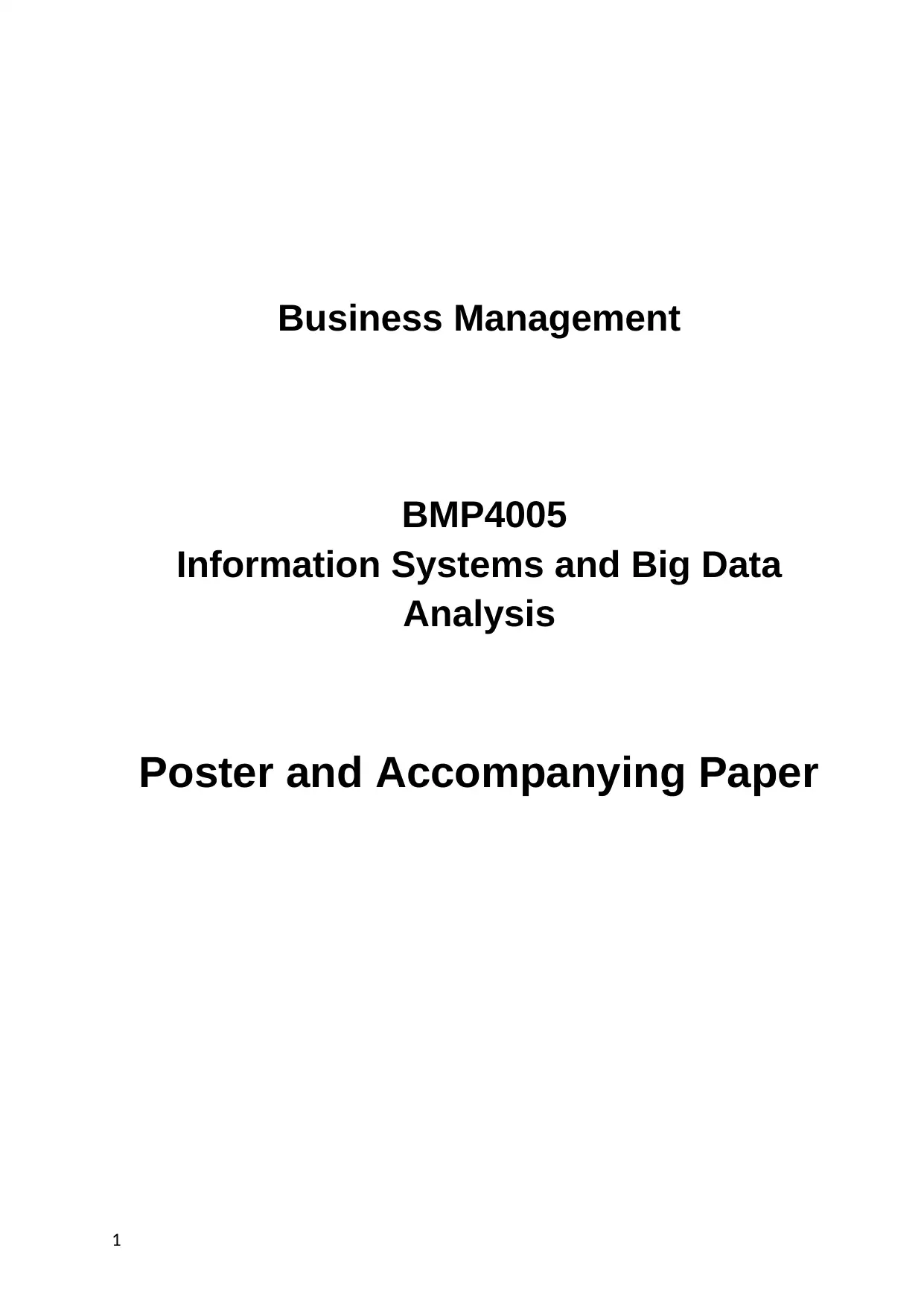
Business Management
BMP4005
Information Systems and Big Data
Analysis
Poster and Accompanying Paper
1
BMP4005
Information Systems and Big Data
Analysis
Poster and Accompanying Paper
1
Paraphrase This Document
Need a fresh take? Get an instant paraphrase of this document with our AI Paraphraser
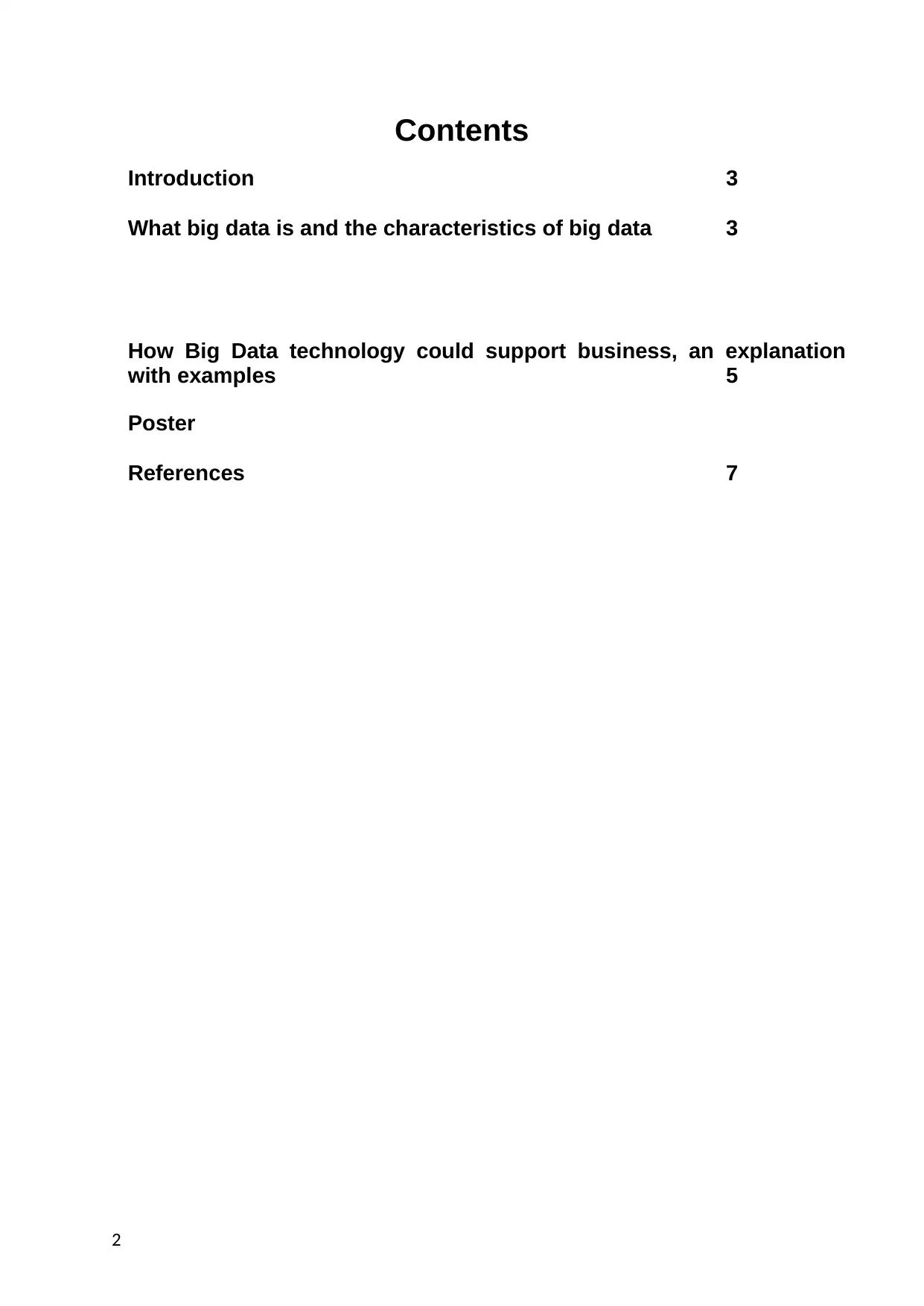
Contents
Introduction 3
What big data is and the characteristics of big data 3
How Big Data technology could support business, an explanation
with examples 5
Poster
References 7
2
Introduction 3
What big data is and the characteristics of big data 3
How Big Data technology could support business, an explanation
with examples 5
Poster
References 7
2
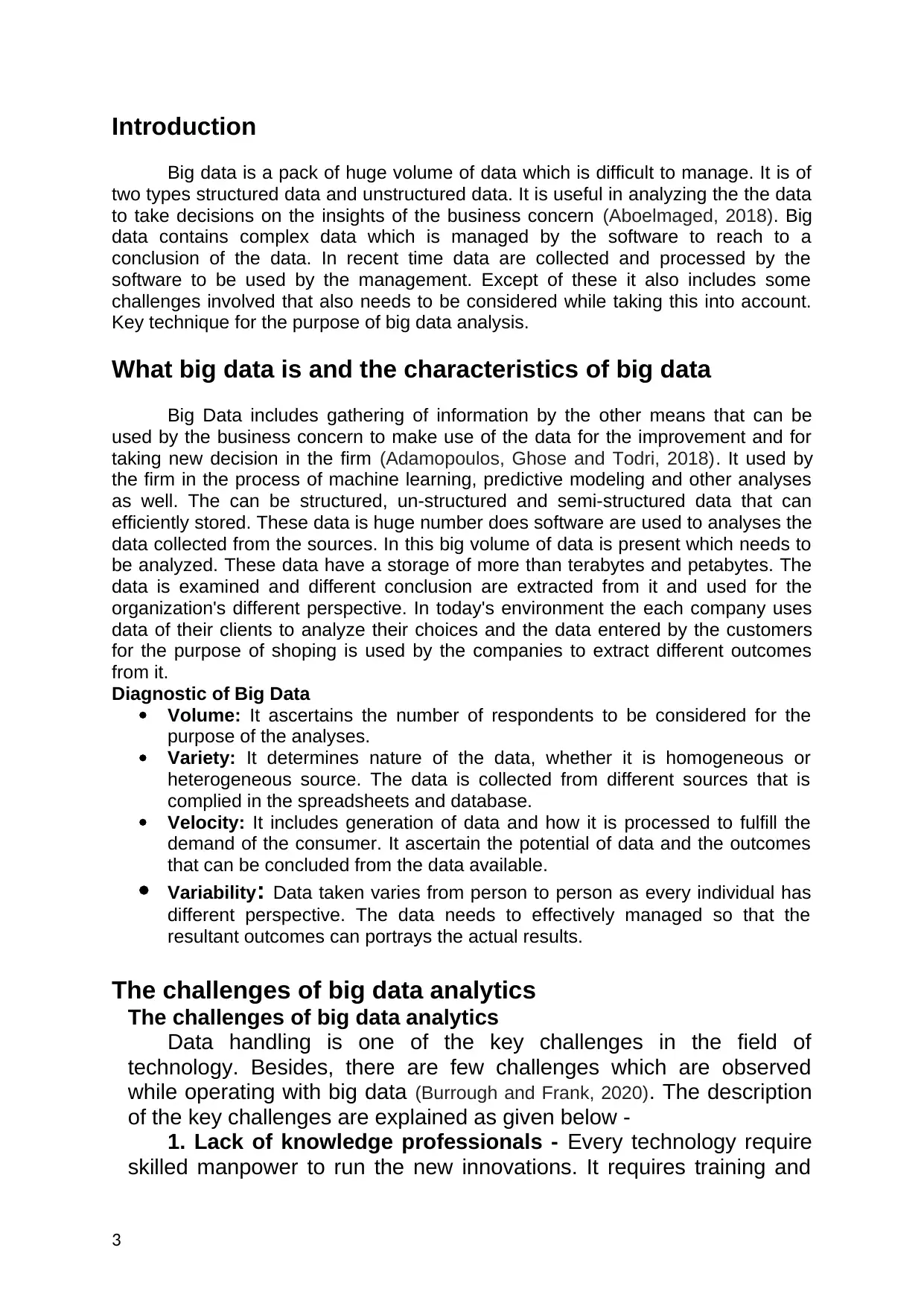
Introduction
Big data is a pack of huge volume of data which is difficult to manage. It is of
two types structured data and unstructured data. It is useful in analyzing the the data
to take decisions on the insights of the business concern (Aboelmaged, 2018). Big
data contains complex data which is managed by the software to reach to a
conclusion of the data. In recent time data are collected and processed by the
software to be used by the management. Except of these it also includes some
challenges involved that also needs to be considered while taking this into account.
Key technique for the purpose of big data analysis.
What big data is and the characteristics of big data
Big Data includes gathering of information by the other means that can be
used by the business concern to make use of the data for the improvement and for
taking new decision in the firm (Adamopoulos, Ghose and Todri, 2018). It used by
the firm in the process of machine learning, predictive modeling and other analyses
as well. The can be structured, un-structured and semi-structured data that can
efficiently stored. These data is huge number does software are used to analyses the
data collected from the sources. In this big volume of data is present which needs to
be analyzed. These data have a storage of more than terabytes and petabytes. The
data is examined and different conclusion are extracted from it and used for the
organization's different perspective. In today's environment the each company uses
data of their clients to analyze their choices and the data entered by the customers
for the purpose of shoping is used by the companies to extract different outcomes
from it.
Diagnostic of Big Data
Volume: It ascertains the number of respondents to be considered for the
purpose of the analyses.
Variety: It determines nature of the data, whether it is homogeneous or
heterogeneous source. The data is collected from different sources that is
complied in the spreadsheets and database.
Velocity: It includes generation of data and how it is processed to fulfill the
demand of the consumer. It ascertain the potential of data and the outcomes
that can be concluded from the data available.
Variability: Data taken varies from person to person as every individual has
different perspective. The data needs to effectively managed so that the
resultant outcomes can portrays the actual results.
The challenges of big data analytics
The challenges of big data analytics
Data handling is one of the key challenges in the field of
technology. Besides, there are few challenges which are observed
while operating with big data (Burrough and Frank, 2020). The description
of the key challenges are explained as given below -
1. Lack of knowledge professionals - Every technology require
skilled manpower to run the new innovations. It requires training and
3
Big data is a pack of huge volume of data which is difficult to manage. It is of
two types structured data and unstructured data. It is useful in analyzing the the data
to take decisions on the insights of the business concern (Aboelmaged, 2018). Big
data contains complex data which is managed by the software to reach to a
conclusion of the data. In recent time data are collected and processed by the
software to be used by the management. Except of these it also includes some
challenges involved that also needs to be considered while taking this into account.
Key technique for the purpose of big data analysis.
What big data is and the characteristics of big data
Big Data includes gathering of information by the other means that can be
used by the business concern to make use of the data for the improvement and for
taking new decision in the firm (Adamopoulos, Ghose and Todri, 2018). It used by
the firm in the process of machine learning, predictive modeling and other analyses
as well. The can be structured, un-structured and semi-structured data that can
efficiently stored. These data is huge number does software are used to analyses the
data collected from the sources. In this big volume of data is present which needs to
be analyzed. These data have a storage of more than terabytes and petabytes. The
data is examined and different conclusion are extracted from it and used for the
organization's different perspective. In today's environment the each company uses
data of their clients to analyze their choices and the data entered by the customers
for the purpose of shoping is used by the companies to extract different outcomes
from it.
Diagnostic of Big Data
Volume: It ascertains the number of respondents to be considered for the
purpose of the analyses.
Variety: It determines nature of the data, whether it is homogeneous or
heterogeneous source. The data is collected from different sources that is
complied in the spreadsheets and database.
Velocity: It includes generation of data and how it is processed to fulfill the
demand of the consumer. It ascertain the potential of data and the outcomes
that can be concluded from the data available.
Variability: Data taken varies from person to person as every individual has
different perspective. The data needs to effectively managed so that the
resultant outcomes can portrays the actual results.
The challenges of big data analytics
The challenges of big data analytics
Data handling is one of the key challenges in the field of
technology. Besides, there are few challenges which are observed
while operating with big data (Burrough and Frank, 2020). The description
of the key challenges are explained as given below -
1. Lack of knowledge professionals - Every technology require
skilled manpower to run the new innovations. It requires training and
3
⊘ This is a preview!⊘
Do you want full access?
Subscribe today to unlock all pages.

Trusted by 1+ million students worldwide
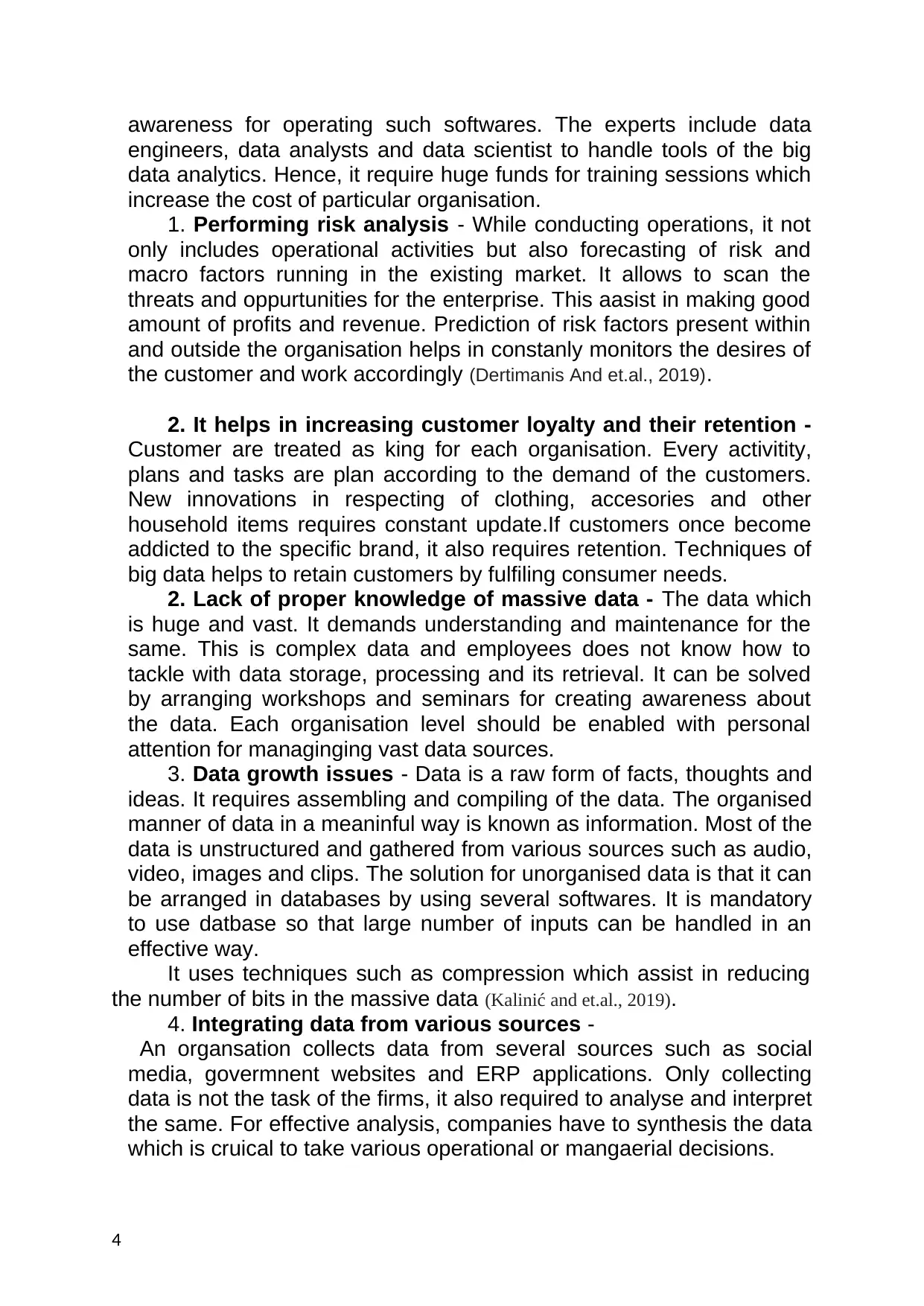
awareness for operating such softwares. The experts include data
engineers, data analysts and data scientist to handle tools of the big
data analytics. Hence, it require huge funds for training sessions which
increase the cost of particular organisation.
1. Performing risk analysis - While conducting operations, it not
only includes operational activities but also forecasting of risk and
macro factors running in the existing market. It allows to scan the
threats and oppurtunities for the enterprise. This aasist in making good
amount of profits and revenue. Prediction of risk factors present within
and outside the organisation helps in constanly monitors the desires of
the customer and work accordingly (Dertimanis And et.al., 2019).
2. It helps in increasing customer loyalty and their retention -
Customer are treated as king for each organisation. Every activitity,
plans and tasks are plan according to the demand of the customers.
New innovations in respecting of clothing, accesories and other
household items requires constant update.If customers once become
addicted to the specific brand, it also requires retention. Techniques of
big data helps to retain customers by fulfiling consumer needs.
2. Lack of proper knowledge of massive data - The data which
is huge and vast. It demands understanding and maintenance for the
same. This is complex data and employees does not know how to
tackle with data storage, processing and its retrieval. It can be solved
by arranging workshops and seminars for creating awareness about
the data. Each organisation level should be enabled with personal
attention for managinging vast data sources.
3. Data growth issues - Data is a raw form of facts, thoughts and
ideas. It requires assembling and compiling of the data. The organised
manner of data in a meaninful way is known as information. Most of the
data is unstructured and gathered from various sources such as audio,
video, images and clips. The solution for unorganised data is that it can
be arranged in databases by using several softwares. It is mandatory
to use datbase so that large number of inputs can be handled in an
effective way.
It uses techniques such as compression which assist in reducing
the number of bits in the massive data (Kalinić and et.al., 2019).
4. Integrating data from various sources -
An organsation collects data from several sources such as social
media, govermnent websites and ERP applications. Only collecting
data is not the task of the firms, it also required to analyse and interpret
the same. For effective analysis, companies have to synthesis the data
which is cruical to take various operational or mangaerial decisions.
4
engineers, data analysts and data scientist to handle tools of the big
data analytics. Hence, it require huge funds for training sessions which
increase the cost of particular organisation.
1. Performing risk analysis - While conducting operations, it not
only includes operational activities but also forecasting of risk and
macro factors running in the existing market. It allows to scan the
threats and oppurtunities for the enterprise. This aasist in making good
amount of profits and revenue. Prediction of risk factors present within
and outside the organisation helps in constanly monitors the desires of
the customer and work accordingly (Dertimanis And et.al., 2019).
2. It helps in increasing customer loyalty and their retention -
Customer are treated as king for each organisation. Every activitity,
plans and tasks are plan according to the demand of the customers.
New innovations in respecting of clothing, accesories and other
household items requires constant update.If customers once become
addicted to the specific brand, it also requires retention. Techniques of
big data helps to retain customers by fulfiling consumer needs.
2. Lack of proper knowledge of massive data - The data which
is huge and vast. It demands understanding and maintenance for the
same. This is complex data and employees does not know how to
tackle with data storage, processing and its retrieval. It can be solved
by arranging workshops and seminars for creating awareness about
the data. Each organisation level should be enabled with personal
attention for managinging vast data sources.
3. Data growth issues - Data is a raw form of facts, thoughts and
ideas. It requires assembling and compiling of the data. The organised
manner of data in a meaninful way is known as information. Most of the
data is unstructured and gathered from various sources such as audio,
video, images and clips. The solution for unorganised data is that it can
be arranged in databases by using several softwares. It is mandatory
to use datbase so that large number of inputs can be handled in an
effective way.
It uses techniques such as compression which assist in reducing
the number of bits in the massive data (Kalinić and et.al., 2019).
4. Integrating data from various sources -
An organsation collects data from several sources such as social
media, govermnent websites and ERP applications. Only collecting
data is not the task of the firms, it also required to analyse and interpret
the same. For effective analysis, companies have to synthesis the data
which is cruical to take various operational or mangaerial decisions.
4
Paraphrase This Document
Need a fresh take? Get an instant paraphrase of this document with our AI Paraphraser
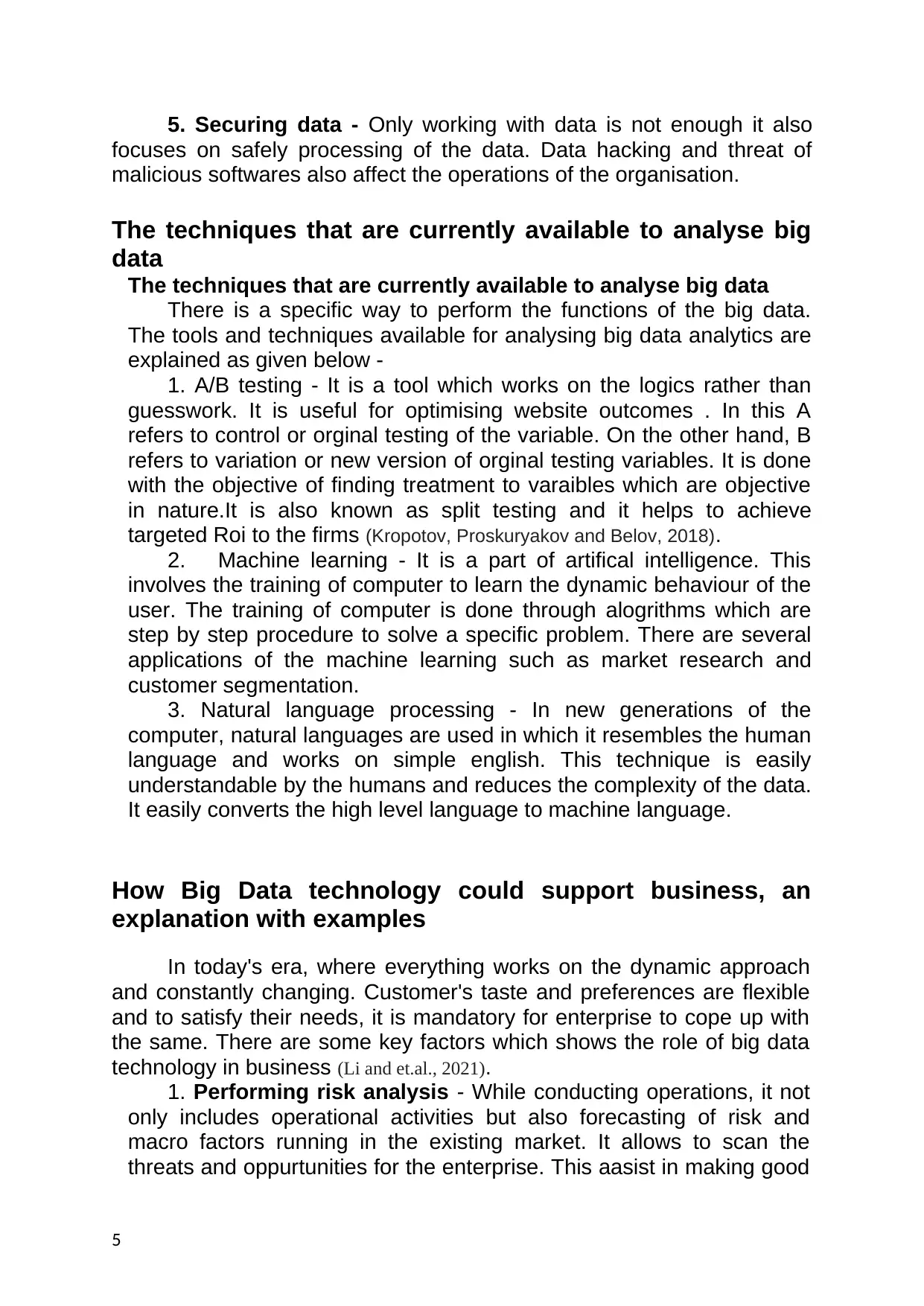
5. Securing data - Only working with data is not enough it also
focuses on safely processing of the data. Data hacking and threat of
malicious softwares also affect the operations of the organisation.
The techniques that are currently available to analyse big
data
The techniques that are currently available to analyse big data
There is a specific way to perform the functions of the big data.
The tools and techniques available for analysing big data analytics are
explained as given below -
1. A/B testing - It is a tool which works on the logics rather than
guesswork. It is useful for optimising website outcomes . In this A
refers to control or orginal testing of the variable. On the other hand, B
refers to variation or new version of orginal testing variables. It is done
with the objective of finding treatment to varaibles which are objective
in nature.It is also known as split testing and it helps to achieve
targeted Roi to the firms (Kropotov, Proskuryakov and Belov, 2018).
2. Machine learning - It is a part of artifical intelligence. This
involves the training of computer to learn the dynamic behaviour of the
user. The training of computer is done through alogrithms which are
step by step procedure to solve a specific problem. There are several
applications of the machine learning such as market research and
customer segmentation.
3. Natural language processing - In new generations of the
computer, natural languages are used in which it resembles the human
language and works on simple english. This technique is easily
understandable by the humans and reduces the complexity of the data.
It easily converts the high level language to machine language.
How Big Data technology could support business, an
explanation with examples
In today's era, where everything works on the dynamic approach
and constantly changing. Customer's taste and preferences are flexible
and to satisfy their needs, it is mandatory for enterprise to cope up with
the same. There are some key factors which shows the role of big data
technology in business (Li and et.al., 2021).
1. Performing risk analysis - While conducting operations, it not
only includes operational activities but also forecasting of risk and
macro factors running in the existing market. It allows to scan the
threats and oppurtunities for the enterprise. This aasist in making good
5
focuses on safely processing of the data. Data hacking and threat of
malicious softwares also affect the operations of the organisation.
The techniques that are currently available to analyse big
data
The techniques that are currently available to analyse big data
There is a specific way to perform the functions of the big data.
The tools and techniques available for analysing big data analytics are
explained as given below -
1. A/B testing - It is a tool which works on the logics rather than
guesswork. It is useful for optimising website outcomes . In this A
refers to control or orginal testing of the variable. On the other hand, B
refers to variation or new version of orginal testing variables. It is done
with the objective of finding treatment to varaibles which are objective
in nature.It is also known as split testing and it helps to achieve
targeted Roi to the firms (Kropotov, Proskuryakov and Belov, 2018).
2. Machine learning - It is a part of artifical intelligence. This
involves the training of computer to learn the dynamic behaviour of the
user. The training of computer is done through alogrithms which are
step by step procedure to solve a specific problem. There are several
applications of the machine learning such as market research and
customer segmentation.
3. Natural language processing - In new generations of the
computer, natural languages are used in which it resembles the human
language and works on simple english. This technique is easily
understandable by the humans and reduces the complexity of the data.
It easily converts the high level language to machine language.
How Big Data technology could support business, an
explanation with examples
In today's era, where everything works on the dynamic approach
and constantly changing. Customer's taste and preferences are flexible
and to satisfy their needs, it is mandatory for enterprise to cope up with
the same. There are some key factors which shows the role of big data
technology in business (Li and et.al., 2021).
1. Performing risk analysis - While conducting operations, it not
only includes operational activities but also forecasting of risk and
macro factors running in the existing market. It allows to scan the
threats and oppurtunities for the enterprise. This aasist in making good
5
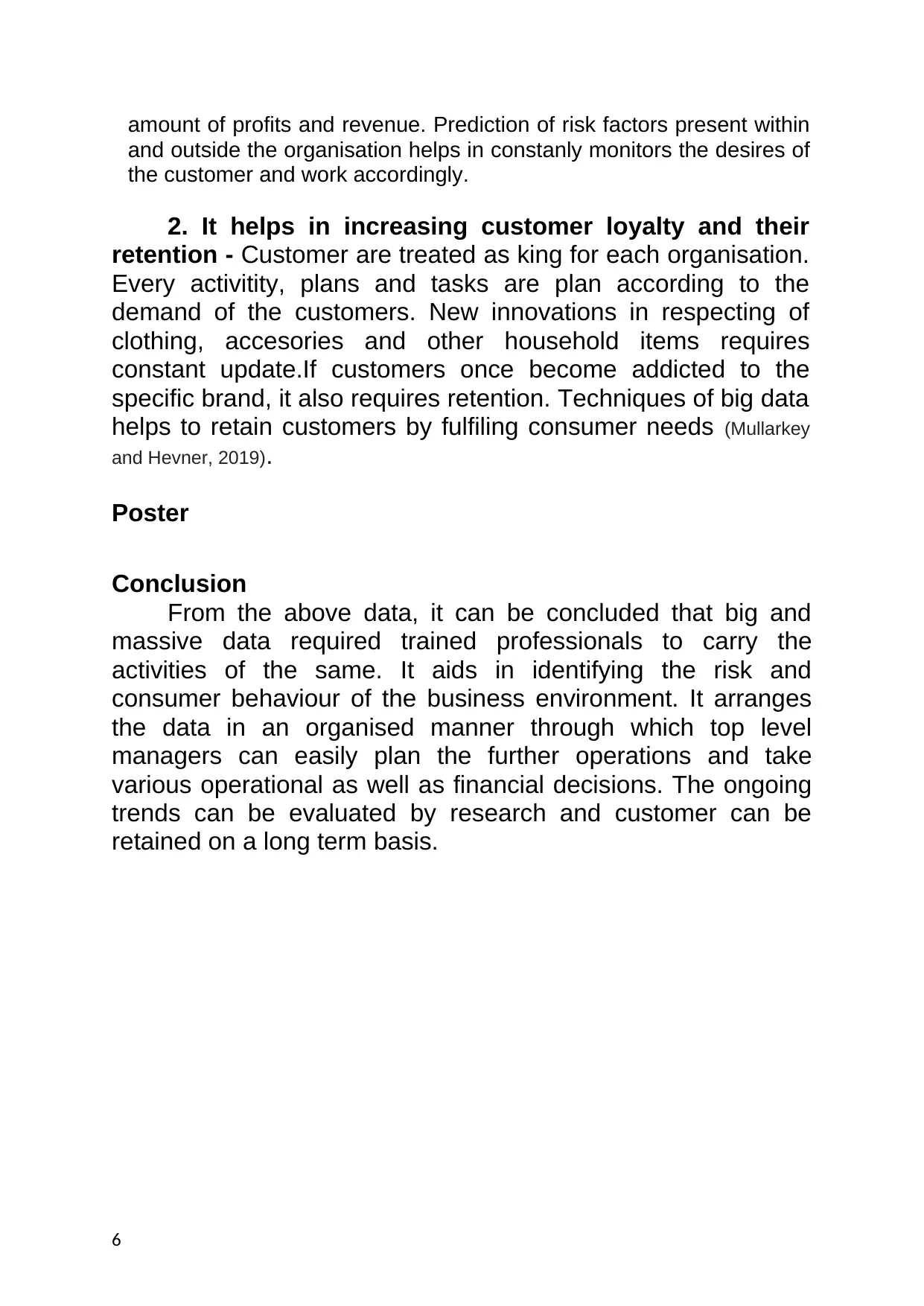
amount of profits and revenue. Prediction of risk factors present within
and outside the organisation helps in constanly monitors the desires of
the customer and work accordingly.
2. It helps in increasing customer loyalty and their
retention - Customer are treated as king for each organisation.
Every activitity, plans and tasks are plan according to the
demand of the customers. New innovations in respecting of
clothing, accesories and other household items requires
constant update.If customers once become addicted to the
specific brand, it also requires retention. Techniques of big data
helps to retain customers by fulfiling consumer needs (Mullarkey
and Hevner, 2019).
Poster
Conclusion
From the above data, it can be concluded that big and
massive data required trained professionals to carry the
activities of the same. It aids in identifying the risk and
consumer behaviour of the business environment. It arranges
the data in an organised manner through which top level
managers can easily plan the further operations and take
various operational as well as financial decisions. The ongoing
trends can be evaluated by research and customer can be
retained on a long term basis.
6
and outside the organisation helps in constanly monitors the desires of
the customer and work accordingly.
2. It helps in increasing customer loyalty and their
retention - Customer are treated as king for each organisation.
Every activitity, plans and tasks are plan according to the
demand of the customers. New innovations in respecting of
clothing, accesories and other household items requires
constant update.If customers once become addicted to the
specific brand, it also requires retention. Techniques of big data
helps to retain customers by fulfiling consumer needs (Mullarkey
and Hevner, 2019).
Poster
Conclusion
From the above data, it can be concluded that big and
massive data required trained professionals to carry the
activities of the same. It aids in identifying the risk and
consumer behaviour of the business environment. It arranges
the data in an organised manner through which top level
managers can easily plan the further operations and take
various operational as well as financial decisions. The ongoing
trends can be evaluated by research and customer can be
retained on a long term basis.
6
⊘ This is a preview!⊘
Do you want full access?
Subscribe today to unlock all pages.

Trusted by 1+ million students worldwide
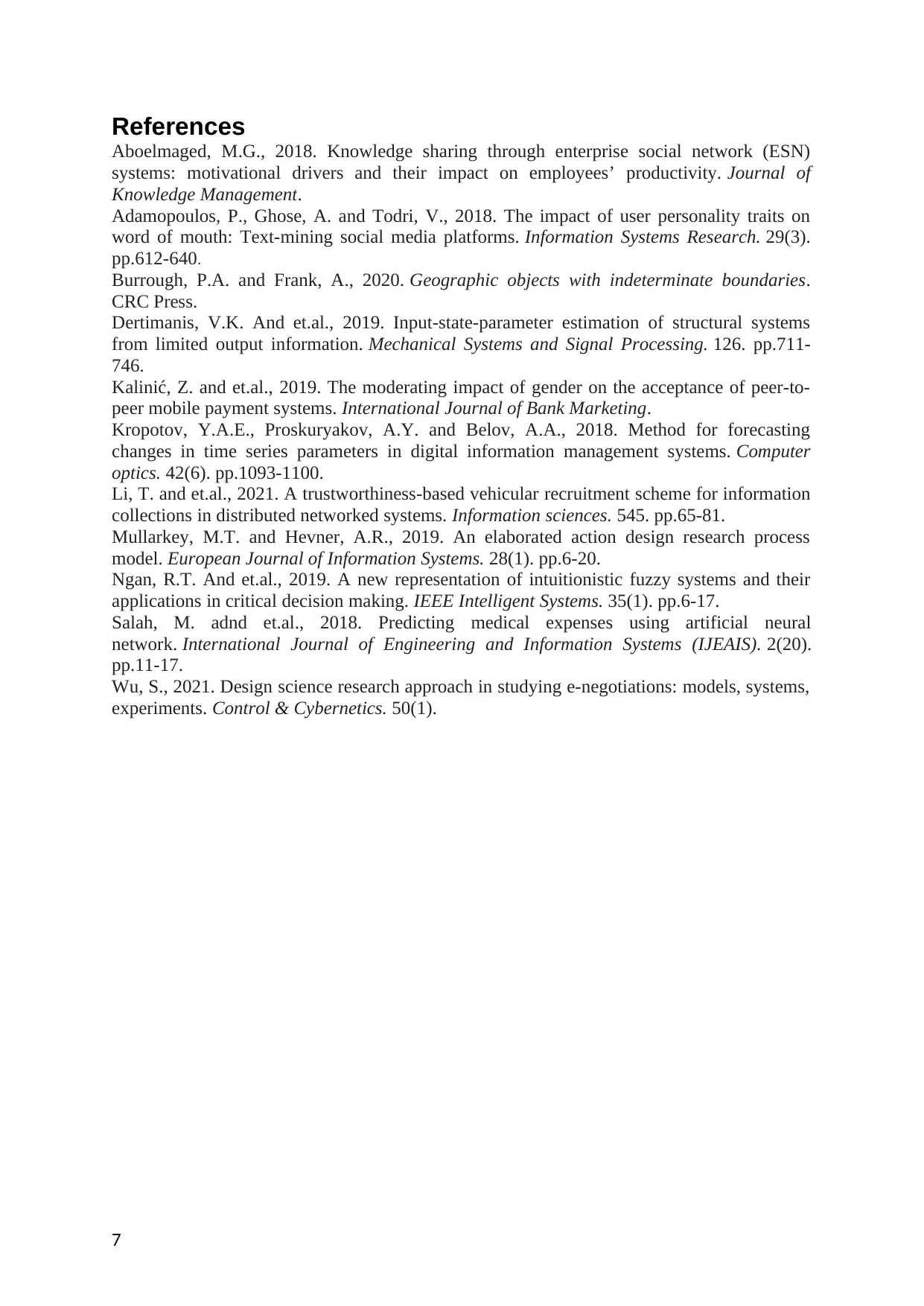
References
Aboelmaged, M.G., 2018. Knowledge sharing through enterprise social network (ESN)
systems: motivational drivers and their impact on employees’ productivity. Journal of
Knowledge Management.
Adamopoulos, P., Ghose, A. and Todri, V., 2018. The impact of user personality traits on
word of mouth: Text-mining social media platforms. Information Systems Research. 29(3).
pp.612-640.
Burrough, P.A. and Frank, A., 2020. Geographic objects with indeterminate boundaries.
CRC Press.
Dertimanis, V.K. And et.al., 2019. Input-state-parameter estimation of structural systems
from limited output information. Mechanical Systems and Signal Processing. 126. pp.711-
746.
Kalinić, Z. and et.al., 2019. The moderating impact of gender on the acceptance of peer-to-
peer mobile payment systems. International Journal of Bank Marketing.
Kropotov, Y.A.E., Proskuryakov, A.Y. and Belov, A.A., 2018. Method for forecasting
changes in time series parameters in digital information management systems. Computer
optics. 42(6). pp.1093-1100.
Li, T. and et.al., 2021. A trustworthiness-based vehicular recruitment scheme for information
collections in distributed networked systems. Information sciences. 545. pp.65-81.
Mullarkey, M.T. and Hevner, A.R., 2019. An elaborated action design research process
model. European Journal of Information Systems. 28(1). pp.6-20.
Ngan, R.T. And et.al., 2019. A new representation of intuitionistic fuzzy systems and their
applications in critical decision making. IEEE Intelligent Systems. 35(1). pp.6-17.
Salah, M. adnd et.al., 2018. Predicting medical expenses using artificial neural
network. International Journal of Engineering and Information Systems (IJEAIS). 2(20).
pp.11-17.
Wu, S., 2021. Design science research approach in studying e-negotiations: models, systems,
experiments. Control & Cybernetics. 50(1).
7
Aboelmaged, M.G., 2018. Knowledge sharing through enterprise social network (ESN)
systems: motivational drivers and their impact on employees’ productivity. Journal of
Knowledge Management.
Adamopoulos, P., Ghose, A. and Todri, V., 2018. The impact of user personality traits on
word of mouth: Text-mining social media platforms. Information Systems Research. 29(3).
pp.612-640.
Burrough, P.A. and Frank, A., 2020. Geographic objects with indeterminate boundaries.
CRC Press.
Dertimanis, V.K. And et.al., 2019. Input-state-parameter estimation of structural systems
from limited output information. Mechanical Systems and Signal Processing. 126. pp.711-
746.
Kalinić, Z. and et.al., 2019. The moderating impact of gender on the acceptance of peer-to-
peer mobile payment systems. International Journal of Bank Marketing.
Kropotov, Y.A.E., Proskuryakov, A.Y. and Belov, A.A., 2018. Method for forecasting
changes in time series parameters in digital information management systems. Computer
optics. 42(6). pp.1093-1100.
Li, T. and et.al., 2021. A trustworthiness-based vehicular recruitment scheme for information
collections in distributed networked systems. Information sciences. 545. pp.65-81.
Mullarkey, M.T. and Hevner, A.R., 2019. An elaborated action design research process
model. European Journal of Information Systems. 28(1). pp.6-20.
Ngan, R.T. And et.al., 2019. A new representation of intuitionistic fuzzy systems and their
applications in critical decision making. IEEE Intelligent Systems. 35(1). pp.6-17.
Salah, M. adnd et.al., 2018. Predicting medical expenses using artificial neural
network. International Journal of Engineering and Information Systems (IJEAIS). 2(20).
pp.11-17.
Wu, S., 2021. Design science research approach in studying e-negotiations: models, systems,
experiments. Control & Cybernetics. 50(1).
7
1 out of 7
Related Documents
Your All-in-One AI-Powered Toolkit for Academic Success.
+13062052269
info@desklib.com
Available 24*7 on WhatsApp / Email
![[object Object]](/_next/static/media/star-bottom.7253800d.svg)
Unlock your academic potential
Copyright © 2020–2025 A2Z Services. All Rights Reserved. Developed and managed by ZUCOL.
